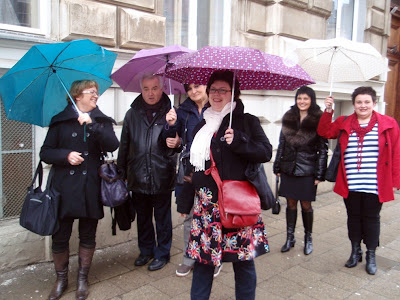 |
| Happy DETVET delegates in Olomouc. Loreta Staškūnienė on left |
The purpose of the project – to form an international sustainable partnership in order to improve VET teachers’ competencies in education techniques – was fully reached and the results gained both at national and international levels. There were six meetings organized, each of them having it’s clear objective and outcomes defined. Before and between the meetings the work was done mostly in the national teams: dissemination, discussions, survey, validation of the chosen technique within local VET teachers, preparation the material for publishing, reporting, etc. At the international level there were carried out such activities as: exchange of methods and state of art analysis, blog design and development, creation and implementation of the investigation tools, announcing of the investigation results and recommendations, etc.
Every participating institution picked the most relevant theme for the teachers’ educational needs in approach (technique) and discussed it with teachers and students in local education environment. The pivotal outcome of the common share is mutual trust and appreciation in the partnership, the brought together competences, contribution of all partner countries disseminated at the European level.
What have we got from the partnership?
After the surveys were made in all countries, there was the clearly defined picture that our teachers need to gain more skills in use of social media, ICT tools, coaching as a method and education in entrepreneurship and innovation. It is well seen in each partners’ Conclusion chapter - different education cultures in countries and different types of institutions suggest different solutions for teachers’ qualification improvement. However, all the partners agree that they have gained from the partnership a lot of experience and know-how that encourages them to meet new challenges and promote institutional development. There are some general outcomes that partners have concluded:
- Much more attention should be given to the shifting paradigm. The Finnish partner (as well as other partners) raises a question of the educational use of social media – the change of culture of teaching. The education phenomena should be released from the closed classrooms and better applied to the workplaces, other surrounding environment; and teachers are supposed to be well prepared for that challenge.
- Higher vocational education and training must be developed, and be maintained more in cooperation with companies and working life.
- Not only pedagogic development is needed but also development of networks (working in teams, coached by a professional trainer) in order to gain efficiency in education and training.
Without the international partnership there wouldn’t be such an effective outcome achieved –new ideas and well applied practice under different circumstances ¬– that brought a lot of creativity and new know-how into our institutions.
Having the chance, I would like to thank all the partners that they were really dedicated to the DETVET project and we – all together – have had great time!!!
Loreta Staškūnienė
The author is the Project Manager of the DETVET Project
